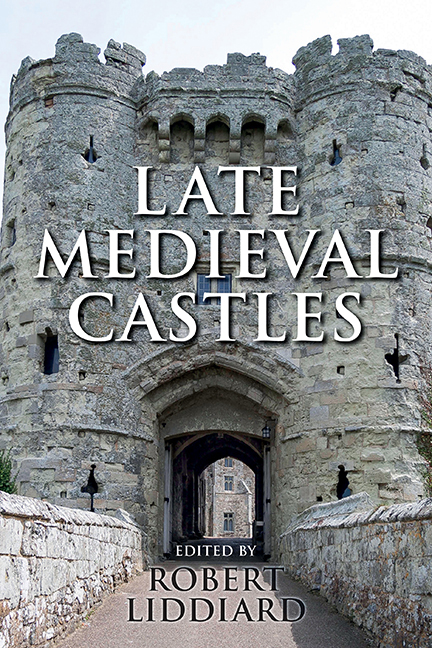Book contents
- Frontmatter
- Contents
- List of Illustrations
- Acknowledgements
- Editor's Preface
- List of Abbreviations
- A Note on the Text
- Introduction
- 1 Fourteenth-Century Castles in Context: Apotheosis or Decline?
- 2 Architects, Advisors and Design at Edward I's Castles in Wales
- 3 The Courtyard and the Tower: Contexts and Symbols in the Development of Late Medieval Great Houses
- 4 Castle Planning in the Fourteenth Century
- 5 Meaningful Constructions: Spatial and Functional Analysis of Medieval Buildings
- 6 Mota, Aula et Turris: The Manor-Houses of the Anglo-Scottish Border
- 7 Lulworth Castle, Dorset
- 8 A Scottish Problem with Castles
- 9 Structural Symbolism in Medieval Castle Architecture
- 10 Specimens of Freedom to Crenellate by Licence
- 11 Some Analysis of the Castle of Bodiam, East Sussex
- 12 English Castles in the Reign Of Edward II
- 13 Castles of Ward and the Changing Pattern of Border Conflict in Ireland
- 14 The Donjon Of Knaresborough: The Castle As Theatre
- 15 The Architecture of Arthurian Enthusiasm: Castle Symbolism in the Reigns of Edward I and his Successors
- 16 Medieval Ornamental Landscapes
- 17 Otherworld Castles in Middle English Arthurian Romance
- Guide to Further Reading
- Index
5 - Meaningful Constructions: Spatial and Functional Analysis of Medieval Buildings
Published online by Cambridge University Press: 29 April 2017
- Frontmatter
- Contents
- List of Illustrations
- Acknowledgements
- Editor's Preface
- List of Abbreviations
- A Note on the Text
- Introduction
- 1 Fourteenth-Century Castles in Context: Apotheosis or Decline?
- 2 Architects, Advisors and Design at Edward I's Castles in Wales
- 3 The Courtyard and the Tower: Contexts and Symbols in the Development of Late Medieval Great Houses
- 4 Castle Planning in the Fourteenth Century
- 5 Meaningful Constructions: Spatial and Functional Analysis of Medieval Buildings
- 6 Mota, Aula et Turris: The Manor-Houses of the Anglo-Scottish Border
- 7 Lulworth Castle, Dorset
- 8 A Scottish Problem with Castles
- 9 Structural Symbolism in Medieval Castle Architecture
- 10 Specimens of Freedom to Crenellate by Licence
- 11 Some Analysis of the Castle of Bodiam, East Sussex
- 12 English Castles in the Reign Of Edward II
- 13 Castles of Ward and the Changing Pattern of Border Conflict in Ireland
- 14 The Donjon Of Knaresborough: The Castle As Theatre
- 15 The Architecture of Arthurian Enthusiasm: Castle Symbolism in the Reigns of Edward I and his Successors
- 16 Medieval Ornamental Landscapes
- 17 Otherworld Castles in Middle English Arthurian Romance
- Guide to Further Reading
- Index
Summary
Spatial analysis has enjoyed a considerable vogue in archaeological studies over the past two decades, though usually applied in prehistoric contexts. The paper applies well-tried techniques to the analysis of complex high-status medieval buildings and demonstrates their superiority in terms of data (especially when used in parallel) on social function and status over subjective analysis based on notions of symbolic or functional characterisation.
Spatial analysis is a widely used term in current archaeological practice, but it describes many disparate approaches tht do not always share the same objectives or methods (e.g. Boast & Yiannouli 1986, 136). It can be used, for example, to denote patterning of artefact distribution from site excavation (e.g. Mytum 1989a; Ellison 1987; Fisher 1985) or from field-walking (Hietala 1984; Hodder & Orton 1976). Very commonly, however, it is used to investigate architectural space (Hillier & Hanson 1984; Foster 1989a; Samson 1990; Dickens 1977). This is the usage in the present paper, which is concerned with spatial analysis as a means of exploring how architectural space has been consciously sub-divided and allocated in the past. There are several other methods of reading the architecture of past societies, notably those that rely on symbolic analysis and attempts to associate buildings with particular social functions (e.g. Richards 1990; Johnson 1986; Coulson 1979), and these will also find their way into the margins of the present paper. One useful framework for the present paper is that offered by Markus: the relationships, as articulated and taught by buildings, of self to self; of self to others (the inhabitant/visitor dichotomy that underlies Hillier & Hanson's theories); and of both self and others to the larger, cosmic Other (Markus 1982, 6).
A starting-point of all these approaches, and of this paper, is that the fundamental structures of a society condition the ways in which groups negotiate rights over space within a building. This insight is far from restricted to archaeological studies, being a commonplace for example in a large body of architectural theory and in the field of environmental behavioural science. That ‘culture is the main influence on the use of space’, taking culture as embracing social relationships, has been a main theme of such studies since the 1960s (Rapoport 1969; 1990, 223).
- Type
- Chapter
- Information
- Late Medieval Castles , pp. 101 - 126Publisher: Boydell & BrewerPrint publication year: 2016



